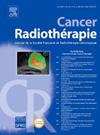Car-T细胞桥接放疗期间暴露于免疫系统
IF 1.4
4区 医学
Q4 ONCOLOGY
引用次数: 0
摘要
目的:本研究的目的是量化桥接放疗对非淋巴瘤免疫细胞的剂量。材料和方法对2023年1月至2024年4月期间在居里研究所(法国巴黎)接受了嵌合抗原受体(Car)-T细胞输注的桥接放疗的所有患者进行了鉴定。计算了每一种免疫细胞的有效剂量。结果纳入9例患者,平均随访时间6个月;一名患者复发。未见2+级毒性报告。免疫细胞的中位有效剂量为0.56 Gy(范围:0.039-2.72 Gy),不同患者有效剂量不同。主要贡献来自积分剂量(0.43 Gy,范围:0.039 ~ 1.42 Gy)。结论:接受Car-T细胞桥接放疗时,免疫系统所接受的剂量因人而异,而整体剂量代表了免疫系统暴露的主要部分。在这种情况下,需要前瞻性的实体数据来评估在桥接放疗中选择放疗技术的作用。本文章由计算机程序翻译,如有差异,请以英文原文为准。
Exposure to the immune system during bridging radiotherapy for Car-T cells
Purpose
The objective of this study was to quantify how much dose from bridging radiotherapy is being delivered to non-lymphoma immune cells.
Material and methods
All patients who underwent bridging radiotherapy between January 2023 and April 2024 at the institut Curie (Paris, France) surrounding the infusion of chimeric antigen receptor (Car)-T cells, were identified. The effective dose to the immune cells was calculated for each of them.
Results
Nine patients were included, with a mean follow-up time of 6 months; one patient experienced a recurrence. No grade 2+ toxicity was reported. Median effective dose to the immune cells was 0.56 Gy (range: 0.039–2.72 Gy) and varied between patients. The main contribution came from the integral dose (0.43 Gy, range: 0.039–1.42 Gy).
Conclusions
The doses received by the immune system when undergoing bridging radiotherapy for Car-T cells can vary considerably from one patient to another, and the integral dose represents the primary part of this exposure of the immune system. Prospective solid data is needed in this context to evaluate the role of choice of radiotherapy techniques in bridging radiotherapy.
求助全文
通过发布文献求助,成功后即可免费获取论文全文。
去求助
来源期刊

Cancer Radiotherapie
医学-核医学
CiteScore
2.20
自引率
23.10%
发文量
129
审稿时长
63 days
期刊介绍:
Cancer/radiothérapie se veut d''abord et avant tout un organe francophone de publication des travaux de recherche en radiothérapie. La revue a pour objectif de diffuser les informations majeures sur les travaux de recherche en cancérologie et tout ce qui touche de près ou de loin au traitement du cancer par les radiations : technologie, radiophysique, radiobiologie et radiothérapie clinique.
 求助内容:
求助内容: 应助结果提醒方式:
应助结果提醒方式:


